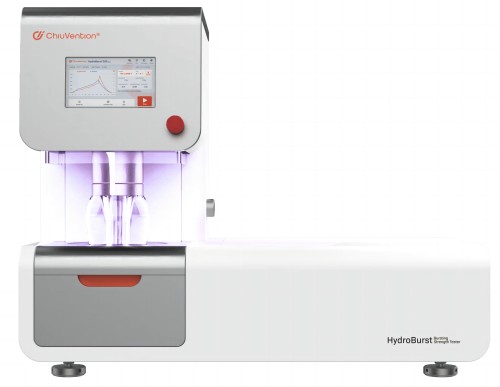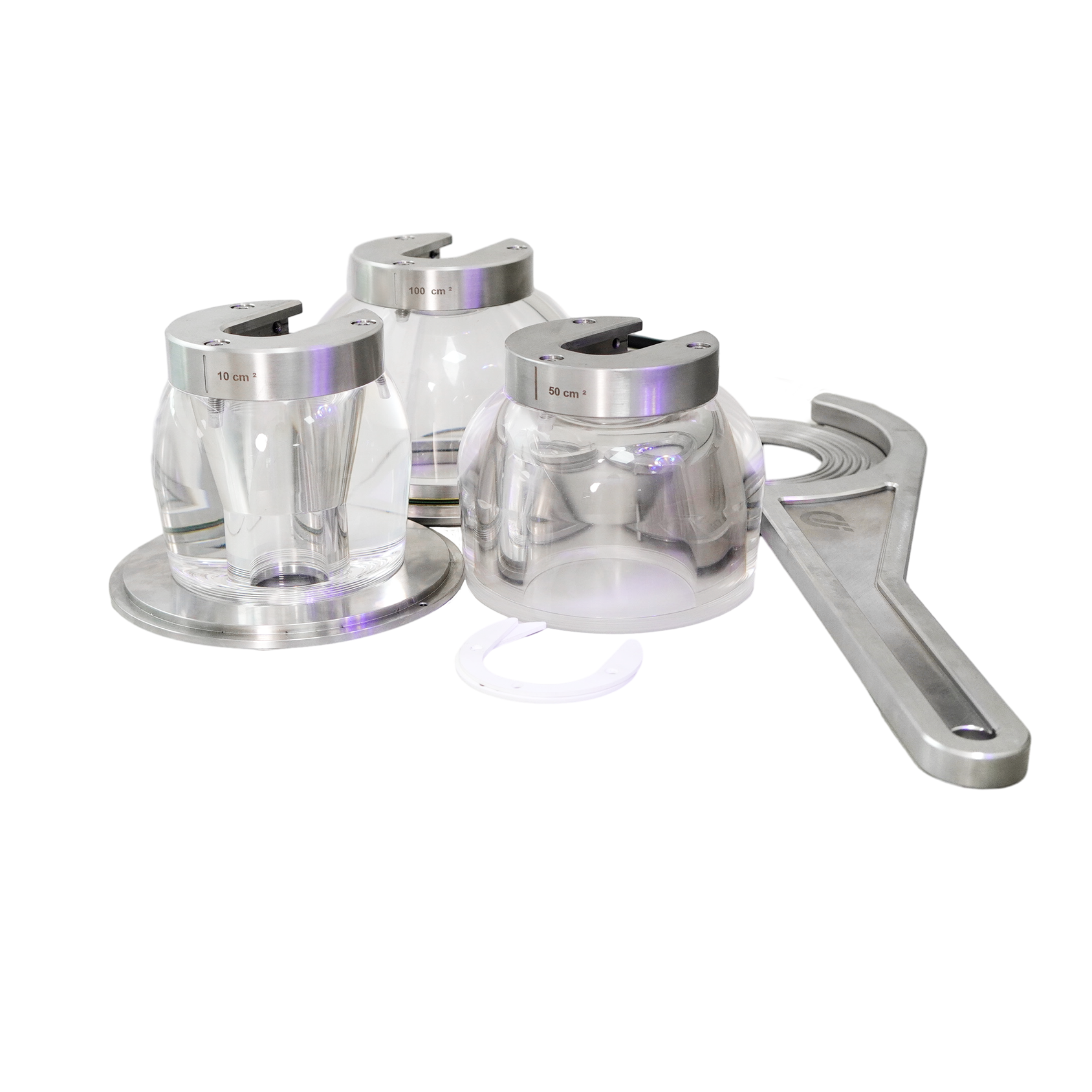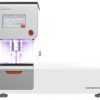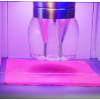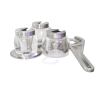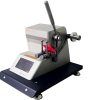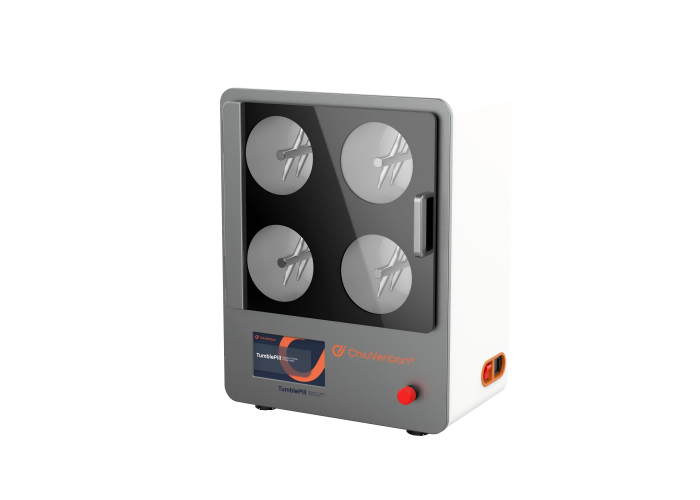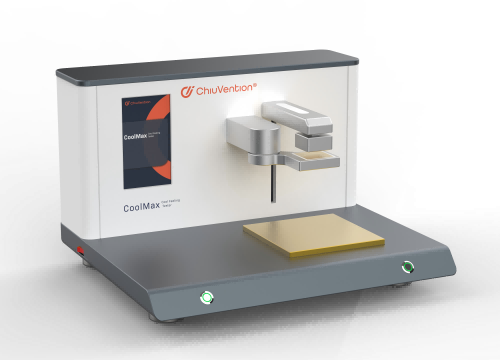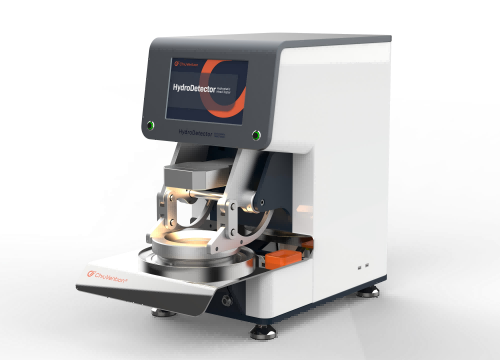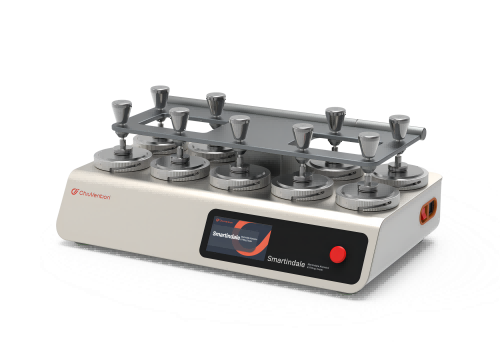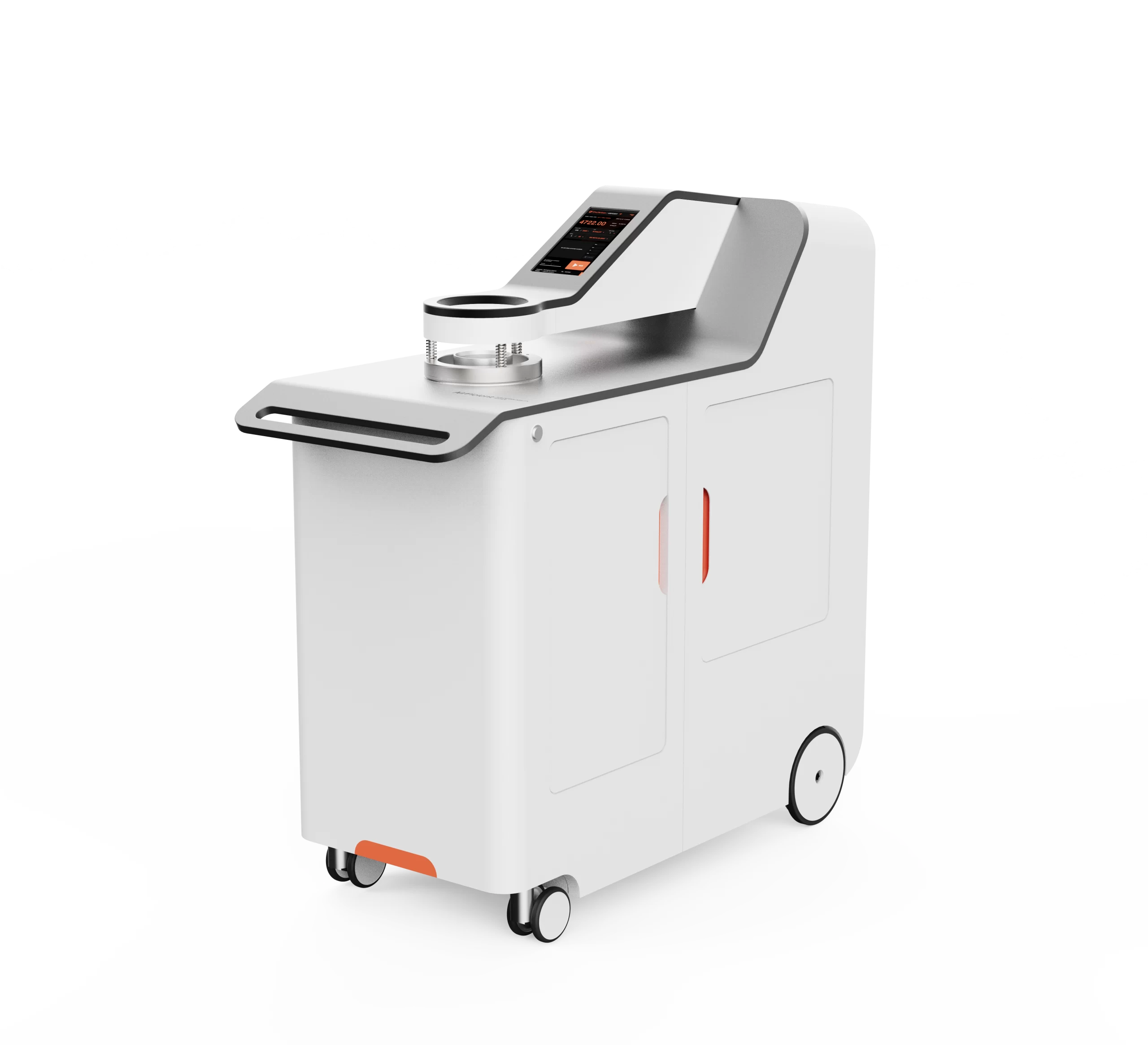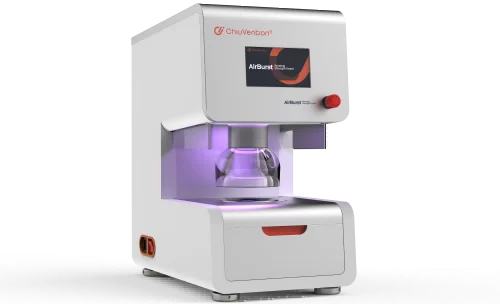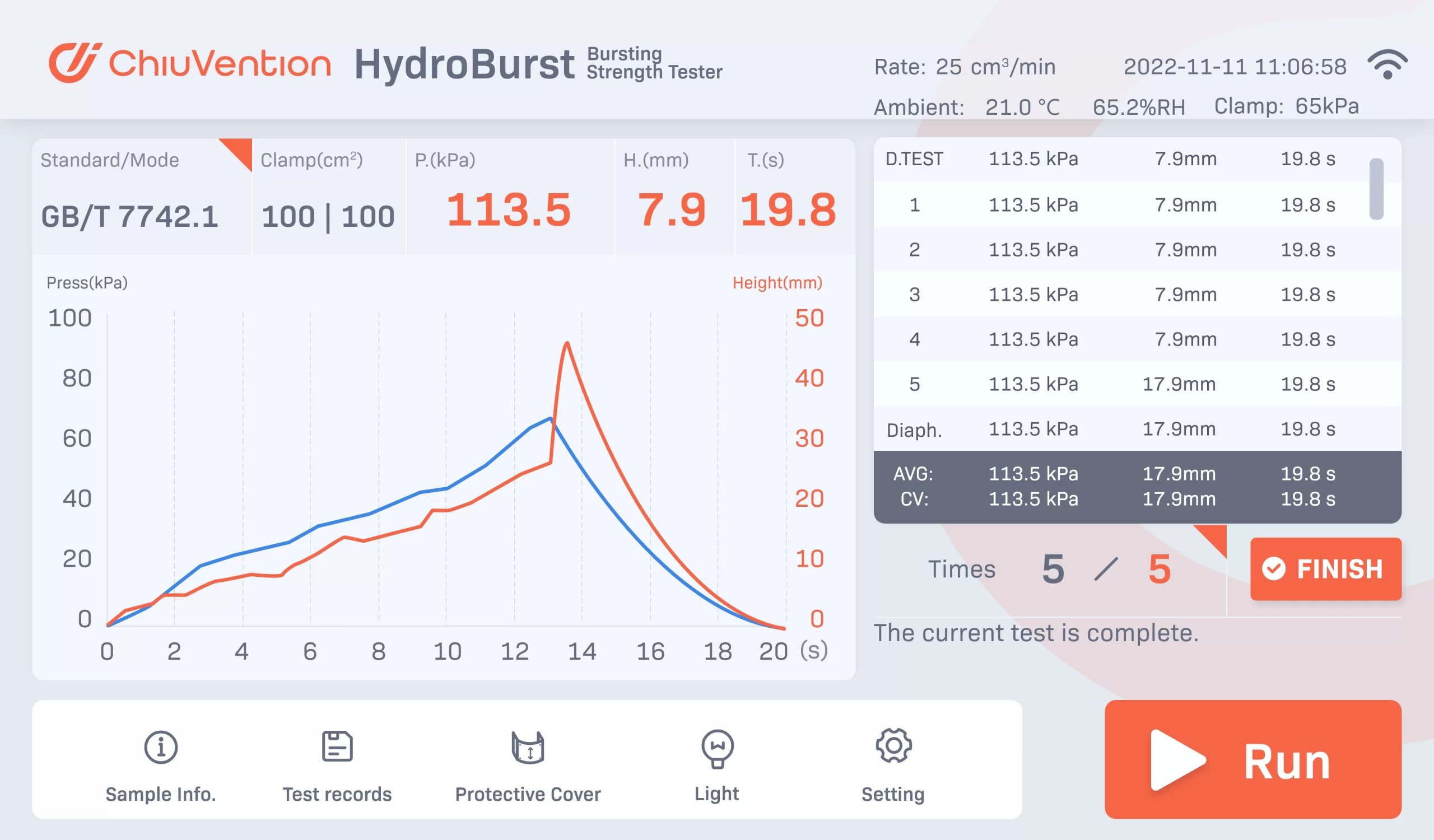
Smart and faster testing
The instrument is connected via IoT to the SmarTexLab APP in the phone/PC. And The app can connect to ERP/LIMS via an API. Or, the instrument can connect directly to ERP/LIMS. There are test orders and sample information in the system, and the instrument can start the test and record the sample info, test process, and test or rating results.
The system will then summarize these into a test report. The report can be sent to SmarTexLab or ERP/LIMS. The relevant parties can view the report in real-time.
Test men can monitor tests for many instruments at once. They can also change test requirements, get alerts before tests end, and stop or repeat tests remotely.
In SmarTexLab, you can set up programs to operate the instruments. You can chat with ChiuVention service staff for quick support. You’ll get reminders that instruments need calibration, maintenance, and new consumables. Regular OTA remote upgrades are available.
Smooth operation, precise and durable
This mullen burst tester’s hydraulic system uses full servo control. It also uses a precise screw drive. These give the system smooth operation, precise and durable transmission, and low noise.
One pre-test can accurately control the bursting speed
The full servo-hydraulic system is controlled by an AI algorithm, together with a precise screw drive, only by one pre-test, the burst testing machine can reach the expansion speed within the standard requirements of the 20s.
Reliable hydraulic bursting strength test
The pressure measurement part of this Fabric BS Tester has a high-precision pressure sensor. It has an accuracy of up to 0.2%, which means the deviation is 0.2% of the largest range.

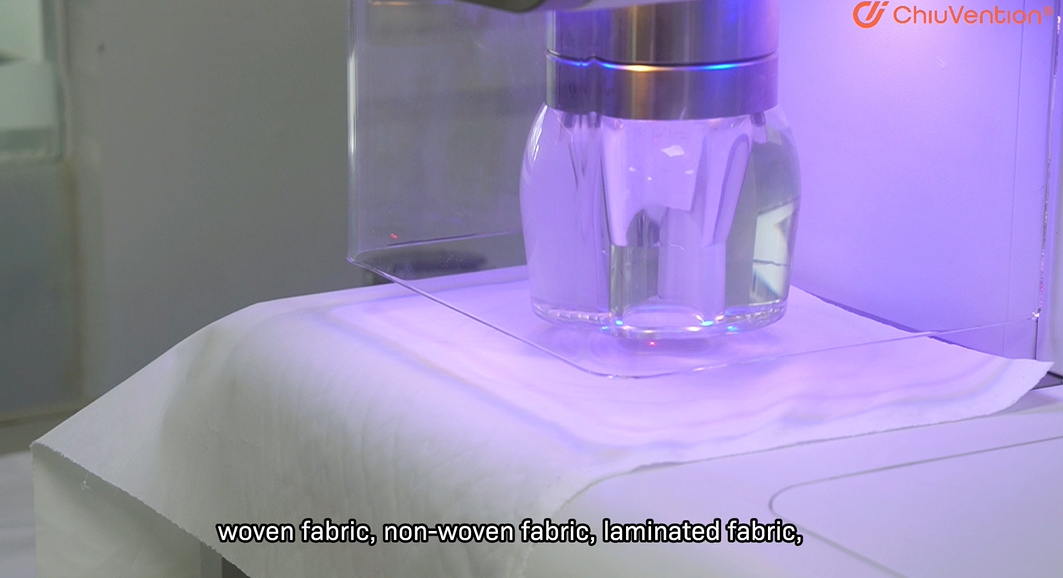
Longer service life of sensors.
This Fabric Bursting Strength Tester has Panasonic laser displacement sensors. They have no rod and are easy to replace. Therefore, they protect sensors better and reduce damage risk. This is compared to traditional rod-type sensors.
Automatic burst tests improve efficiency.
During burst strength testing, the protective cover descends. Then, the Fabric Digital Bursting Strength Tester presses its testing cup. When the burst strength test is done, the testing cup lifts. The protective cover also ascends. The fabric burst strength test process is automated. It has no manual operation. This improves work efficiency and reduces operation risks.
A smart identification system for testing cups.
When changing the burst testing cup, the burst strength tester’s system can identify the cup. Then, it switches the testing parameters. This also improves work efficiency.
Also, the HydroBurst bursting strength tester’s shell is a steel plate. It has electrostatic spraying. This makes it look good. The interior is a high-quality, lightweight, all-aluminum structure. It reduces the fabric Burst Testing Machine’s weight.
Designed in Germany, quality is our life.
All our textile testing instruments are developed in-house and in cooperation with a team of renowned German industrial designers, which makes our instruments of outstanding quality. 100% source factory and factory price.

Application Examples of HydroBurst Burst Tester

Textiles
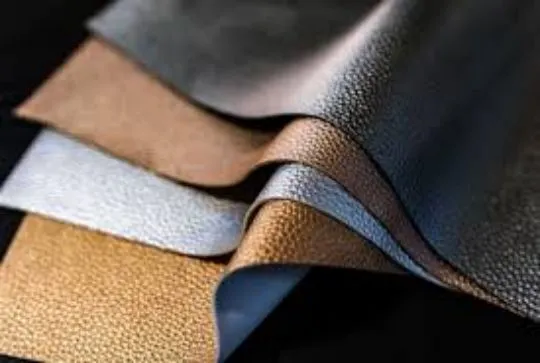
Leather

Package Materials

Waterproof Fabric
Customer Feedback
“We have been purchasing textile test instruments from top brands, and we found ChiuVention is a very trustworthy brand, with the same quality as the top brands and at a reasonable price; The HydroBurst has been running very stably since we have been using it.”
“ChiuVention has an agent in Indonesia, which is more convenient for after-sales service for us. And the most important point is this HydroBurst meets the requirements in all aspects and cost-effective.”
The Specification of HydroBurst Bursting Strength Tester
Model No. 1. CV.142.01 CV142 HydroBurst Bursting Strength Tester
Testing mode: fixed-speed bursting, fixed-pressure bursting, fixed-expansion bursting, and fixed-time bursting.
Measurement range:
0-10 MPa ±1% ( with test cup ≤ 10cm²)
0-3 MPa ±1% ( with test cup = 50cm² )
0-1 MPa ±1% ( with test cup = 100cm²)
Testing rate: 50-500 ml/min.
Hydraulic medium: 7.HY.004 glycerin 500ml/1 pc
Test cup mode, Fixture mode, and related dimensions
Test Cup 1(Standard) 2.Z.CV.142.01 7.3cm²(Dia.30.5mm±0.2mm)
Lower fixture base 1(Standard) 2.Z.CV.142.11 7.3cm²(Dia.30.5mm±0.2mm)
Test Cup 5 (Standard) 2.Z.CV.142.05 50cm² (Dia. 79.8mm±0.2mm
Lower fixture base 5(Standard) 2.Z.CV.142.15 50cm² (Dia. 79.8mm±0.2mm)
Test Cup 2 (Optional) 2.Z.CV.142.02 7.55cm² (Dia. 31mm±0.2mm)
Lower fixture base 2(Optional) 2.Z.CV.142.12 7.55cm² (Dia. 31mm±0.2mm)
Test Cup 4 (Optional) 2.Z.CV.142.04 10cm² (Dia. 35.7mm±0.2mm)
Lower fixture base 4(Optional) 2.Z.CV.142.14 10cm² (Dia. 35.7mm±0.2mm)
Test Cup 6(Optional) 2.Z.CV.142.06 100cm² (Dia. 113 mm±0.2mm)
Lower fixture base 6(Optional) 2.Z.CV.142.16 100cm² (Dia. 113 mm±0.2mm)
Test diaphragm (optional) 4.M.020 Dia. 148 mm * 1.6 mm (10pcs/box)
Maximum expansion height: 65 mm ±1 mm(with a test cup of 50cm² also can be used for 70mm ± 1mm).
Operating environment: temperature 20°C ±5°C, humidity: 50%~70%.
Installation conditions: air supply pressure of 5~8 bar
(ensure the air is clean and dry).
The Power and other information of this Burst Strength Tester
Power 220V 5A 50/60Hz Other voltages require an external transformer
Weight 130kg
Dimension 830*500*660mm (L*W*H)
Standards
FZ/T 01030-2016 Method B
GB∕T 7742.1-2005
ISO 13938-1-2019
ASTM D3786/D3786M-18(2023)
EN 12332-2-2002
| Standard / Specification | FZ/T01030-2016 Method B | GB∕T7742.1-2005 | ISO13938-1-2019 | ASTMD3786/3786M-18(2023) | EN 12332-2-2002 | |
| Test Fixture | 7.3cm2 (φ30.5mm) | √ | √ | √ | √ | – |
| 7.55cm2(φ31±0.75mm) | – | – | – | √ | – | |
| 10cm2 (φ35.7±0.5mm) | – | √ | √ | – | √ | |
| 50cm2
(φ79.8mm) |
– | √ | √ | – | – | |
| 100cm2
(φ113±1mm) |
– | √ | √ | – | √ | |
OUR BROCHURE
Frequently Asked Questions of Fabric Bursting Strength Tester
Textile bursting testers are categorized into hydraulic bursting testers and pneumatic bursting testers according to the testing method, and they each have their own advantages and applicable scenarios. Below is a comparison of the two testers to help you choose the right equipment:
1. Hydraulic Burst Tester
Working Principle: The hydraulic system is utilized to apply pressure to make the liquid expand and push the diaphragm so that the fabric swells under the gradually increasing pressure.
Features:
High Accuracy: The hydraulic system provides more stable pressure and higher testing accuracy, especially for high-strength textiles.
Suitable for heavy or tough fabrics: e.g. canvas, technical textiles, etc., as the hydraulic system is capable of exerting higher forces.
Relatively complex to maintain: hydraulic systems may require regular maintenance, fluids may leak, etc.
Applicable scenarios: High-strength, heavy textiles.
Occasions where high precision testing is required, such as scientific research institutes or standardization laboratories.
2. Pneumatic Expansion Tester
Working Principle: Using air pressure instead of liquid, the pressure is transmitted through the air to push the diaphragm or airbag to exert pressure on the textile until it is swollen.
Features:
Fast: The pneumatic pressure system responds faster and the test time is shorter.
Easy to maintain: pneumatic systems do not require the handling of liquids, simple maintenance, and lower failure rates.
Suitable for light fabrics: for example, knitted fabrics, underwear fabrics, and other lighter textiles.
Applicable Scenarios:
Testing of light or low-strength fabrics.
Places that pay more attention to testing efficiency and easy equipment maintenance, such as daily quality control for garment manufacturers.
3. How to choose
If you are testing high-strength, heavy, or tough textiles and are looking for higher testing accuracy, the Hydraulic Burst Tester may be more suitable.
If you need to test lightweight fabrics quickly and easy maintenance is an important consideration, a pneumatic bursting tester may be a better choice.
You can choose according to your specific application and testing needs.
The principle of the textile hydraulic bursting test is mainly to make the sample expand under the action of a diaphragm by applying liquid pressure until the sample ruptures. The process is described below:
Test Principle
Sample Clamping: The textile sample to be tested is clamped to an extendable diaphragm.
Applying Pressure: Liquid pressure ( glycerin) is applied under the diaphragm and the volume of liquid is increased at a constant rate.
Expansion and Rupture: As the volume of liquid increases, the diaphragm and sample expand until the sample reaches its limit and ruptures. At this point the required swelling and rupture strength is recorded, which is the swelling and rupture strength of the fabric.
This method not only measures the bursting strength of the sample, but also tests its swelling dilatancy, providing an indication of the fabric’s performance when subjected to external forces.
Uniform pressure application: the diaphragm transmits the applied liquid pressure uniformly to the sample, ensuring consistent pressure distribution during the test.
Protecting the sample: the diaphragm acts as a barrier, preventing the liquid from coming into direct contact with the sample and avoiding possible contamination or damage.
Provides elasticity: The malleability of the diaphragm allows it to expand as the pressure increases, thus pushing the sample outward until it ruptures. This property allows the diaphragm to accommodate samples of different materials and thicknesses.
In short, diaphragms are not only the medium for applying pressure during hydraulic burst testing, but they are also a key component in ensuring the accuracy and reliability of the burst test.
1. Ensuring stability of test conditions
Preliminary testing of the equipment ensures that parameters such as hydraulic system pressure, pressurization rate and sample clamping method are in the correct range, thus avoiding unwanted errors in formal testing.
2. Verify sample consistency
Prior to formal testing, pre-testing allows the uniformity and consistency of the samples to be evaluated. By conducting preliminary tests on several samples, possible defects or inhomogeneities can be identified, thus ensuring the reliability of subsequent bursting strength test results.
3. Adjusting the pressurization rate
Pre-testing can help determine the proper pressurization rate to ensure that the sample breaks within a specified time frame. For example, some fabrics may require a specific pressurization rate to achieve the desired burst time (e.g., 30±10 seconds), and the pre-test can help adjust equipment settings to meet these requirements.
The Bursting Strength Machine evaluates many materials. These include knitted, woven, and non-woven fabric. Also, laminated material, elastic woven fabric, paper, and similar materials.
The HydroBurst tester uses hydraulic bursts. It measures the bursting energy of materials. This approach uses hydraulic stress on a flexible diaphragm. The diaphragm comes into contact with the test sample. We increase the pressure until the fabric breaks. This allows the Bursting Strength Testing Machine to measure the burst’s force and size in both warp and weft, as well as in other directions. This complete testing technique gives a new understanding of the fabric’s burst resistance. It shows how the resistance changes under different strains.
Connecting the smart instrument to your phone is straightforward. Make certain that you have the SmarTexLab app. As soon as it’s installed, connect the instrument through Wi-Fi. The SmarTexLab APP lets you set parameters. It lets you see the test status in real-time from your phone. It gives system warning reminders, replenishment notifications, and more. Moreover, you may easily share fabric bursting strength test outcomes with a single click of the app. This seamless integration complements consumer management, convenience, and accessibility to the testing manner.
The Burst Test Equipment’s hydraulic device is notable. It uses full servo control and specific screw pressure. This design desire guarantees smooth operation. It promises precise and durable transmission. It also promises low noise levels during operation. The full servo machine makes the device more responsive and accurate. The right screw drive mechanism adds to its sturdiness and reliability.
This Bursting Strength Apparatus has a highly precise pressure sensor. It has an impressive accuracy of up to 0.02%. This phase of accuracy means that the deviation in strain size is 0.2% of the highest range. In practice, it ensures that the devices offer precise and dependable results. This lets customers trust the stress measurements.
And about the Bursting Strength Tester Price, please contact us right now, we will offer you the factory price of the Fabric Burst Tester since ChiuVention is a Source Factory.
And about the Bursting Strength
1. Sample preparation
Pay attention to the size and shape of the sample: Make sure that the textile sample to be tested conforms to the dimensions required by the standard. The edges of the sample should be flat to avoid errors in the test data due to irregular shapes.
Sample pre-treatment: Some textiles may require pre-treatment before testing, such as moisture conditioning under standardized temperature and humidity conditions, to ensure repeatability and consistency of test results.
2. Equipment Calibration
Calibration of equipment: The Hydraulic Bursting Tester is calibrated regularly to ensure the accuracy of the pressure transducer, hydraulic system, and displacement transducer.
Hydraulic Fluid Level Check: Ensure that the unit’s hydraulic fluid is at the proper level. An unstable hydraulic system or insufficient oil level may result in uneven pressure changes during the test and affect the test results.
3. Control of test conditions
Standardized test environment: Ensure that the test is carried out in the environment specified in the standard, especially the temperature and humidity conditions, which can have a significant impact on the performance of the textile.
Setting the test rate: Set the rate of increase of the hydraulic pressure according to the standard requirements. Rising the pressure too quickly or too slowly may affect the accuracy of the bursting strength test results.
4. Proper sample mounting
Proper Sample Clamping: The sample needs to be firmly and evenly clamped in the fixture of the test instrument. Uneven clamping can result in uneven stresses on the sample during the Burst Strength Test, which can affect the measurement of the bursting point.
Prevent slipping and damage: Care should be taken to avoid slipping or pre-damaging the sample during the clamping process, especially in the case of delicate or highly elastic materials, where adjustment of the clamping force is important.
5. Monitoring of the test process
Smoothness of hydraulic pressure: When applying hydraulic pressure, keep the pressure growth smooth, avoid sudden increase or decrease of pressure, and ensure that the pressure is uniformly applied to the sample during the test.
Expansion point observation: closely observe the expansion point of the sample during the test to ensure that readings are taken at the maximum expansion point. If the bursting point is not in the expected position, it may be necessary to re-run the test.
6. Safety Measures
Protective measures: During the hydraulic bursting test, the sample will be ruptured under high pressure, which may result in splinters or splashes of liquid. The operator should wear appropriate personal protective equipment, such as goggles, to prevent accidental injury.
Equipment Inspection: Regularly check the equipment’s safety valves, hydraulic system pressure gauges, and other key components to ensure that they are in proper working condition and to avoid overpressurization or malfunctioning of the hydraulic system.
7. Data recording and analysis
Multiple tests: To ensure the reliability of the results, it is often necessary to repeat the test on several samples and take the average value to ensure the representativeness of the data.
Maintenance and care
Regular maintenance: The Hydraulic Expansion Tester uses a hydraulic system, which may be contaminated with hydraulic oil or clogged with pipes over a long period of time. Regular maintenance and replacement of hydraulic oil is an important measure to ensure the long-term stable operation of the equipment.
Cleaning equipment: After each burst test, clean the equipment promptly, especially the hydraulic system and fixtures, to prevent textile fibers or debris from entering the equipment, and affecting the subsequent test.
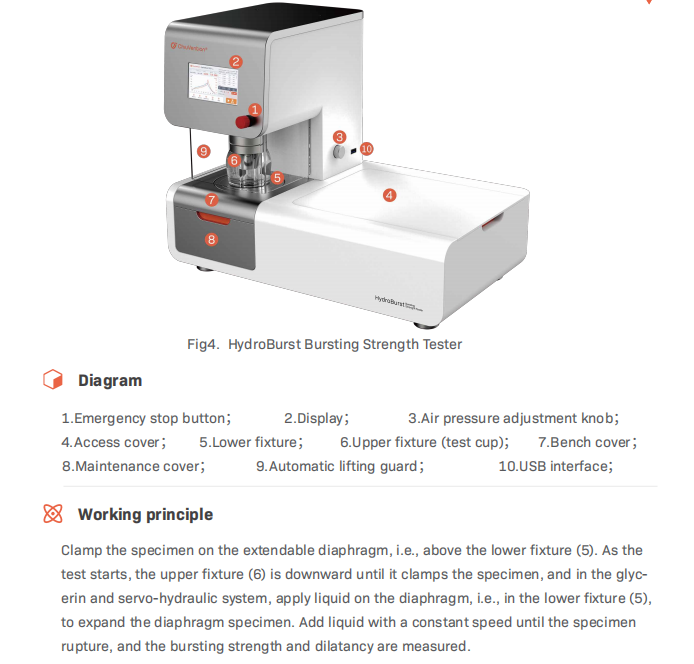
The principle of the hydraulic bursting strength test is that a specimen is clamped on an extendable diaphragm. Liquid pressure is applied under the diaphragm. The liquid’s volume is increased at a constant rate. This causes the diaphragm and specimen to expand until the specimen ruptures. This rupture is measured as the bursting strength. This method also measures the specimen’s expansion.
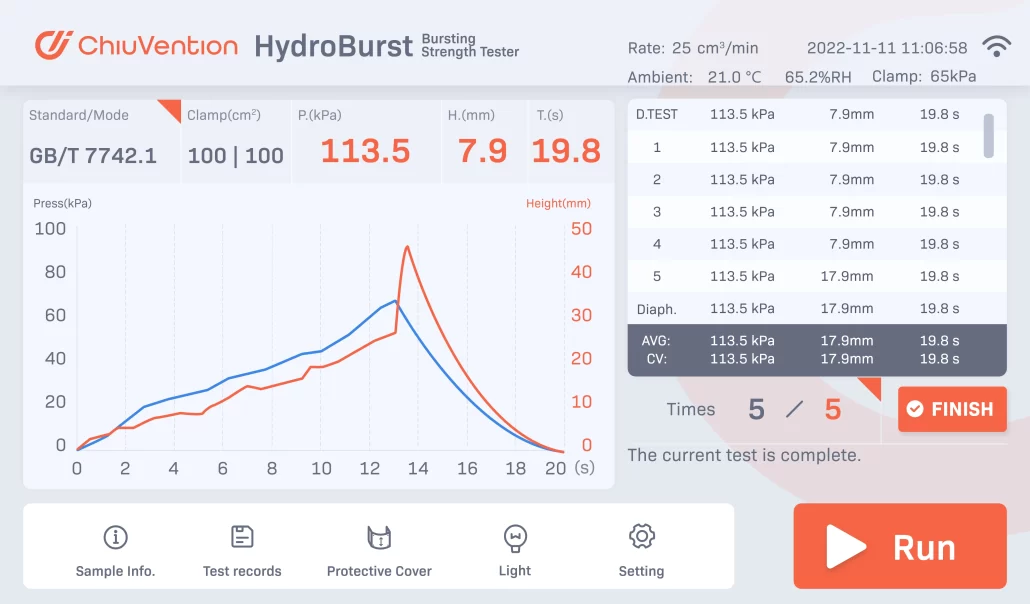
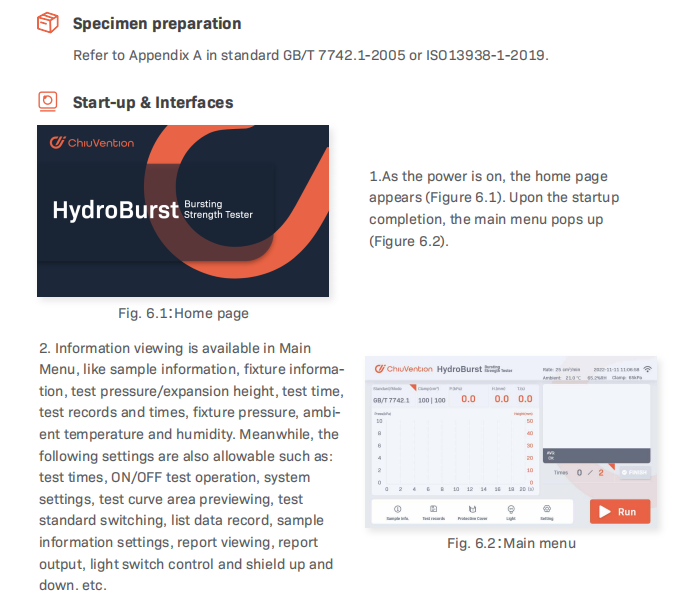
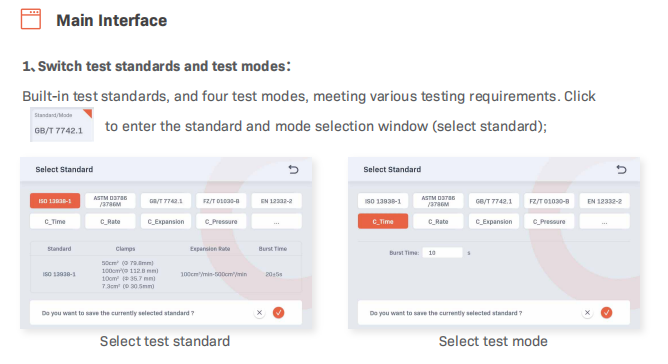
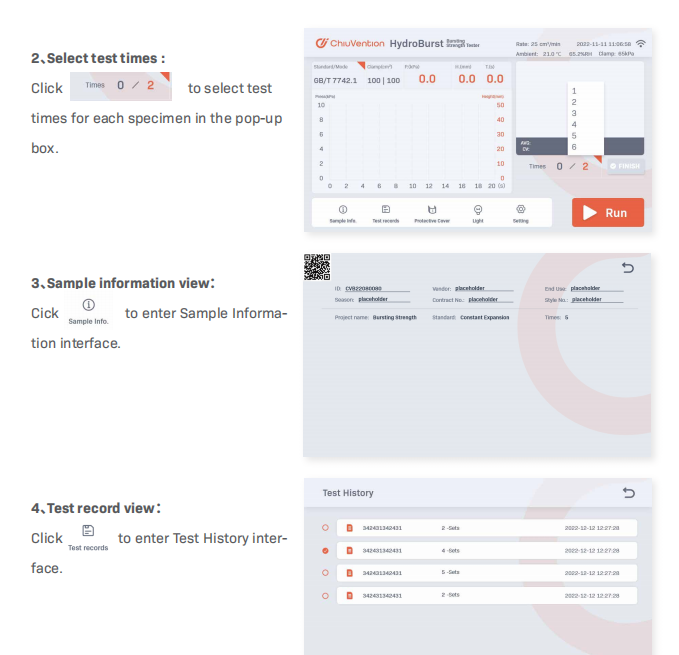
Here is a brief introduction. You can contact us for the full fabric bursting strength test methods and procedure (the operation manual).
1. Click Sample Information to complete the settings of test organization, tester, sample type, and sample information, which will be added to the header of the printed report.
2. Select the corresponding fabric burst strength test standard or customized test mode in the main interface.
3. Replace the upper and lower fixtures for the Bursting Strength test. (Check to see if they match. Do not click.)
4. Sample number: satisfies a single test, convenient for the test completion.
5. Start Test: click Pre-Run, and the lifting shield goes down to press the upper fixture. At that time, the burst test starts, with the test curve and the measurement quantity displayed on the homepage. Once the test ends, the upper fixture and the lifting shield go up.
6. When all tests are completed, click Finish (Note: do click this key or the next test won’t be conducted.) and the data from the current list box generates a report to the report list with others in the history list box cleared. For the detailed data records, refer to the report list.
7. Report view: as the test ends, click to enter the report list page, which shows the stored test records. The records have sample information and the report date in the report column.
8. Click the matching column for the details page.

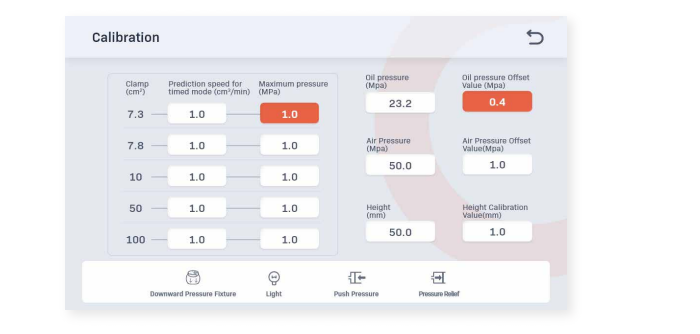
Calibrate the Hydraulic Burst Strength Tester. Connect the gauge to the connector shown above. (NOTE: tighten the gauge 2-3 turns, then open the calibration valve and tighten the gauge again. Any failure may result in damage to the gauge.)
Turn on the pressure gauge and adjust the unit of the pressure gauge to MPa to keep it in line with the Digital Bursting Strength Tester.
Click Settings to enter the calibration interface
Place a specimen on the fixture, and click DOWN to get it pressed.
Click PUSH to pressurize the specimen. When the pressure is between 0.05 – 0.2 MPa, click the “Oil Pressure” button to put the gauge’s value in the white box. Then, confirm.
As pressure calibration is complete, click Relief, and the pressure returns to 0. Then, close the calibration valve and remove the gauge. Then Article 5.4.2.4 (based on the operation manual) Automatic Film Leveling can be applied.
Height calibration: Complying with Article 7.2.3(based on the operation manual), enter 0 in the “Height” box.
Air pressure calibration test: Connect the compressed air tube to a tee connector. Put the air pressure gauge on one end and the air inlet on the other end (rear: AIRINTAKE connector). Enter the value of the air pressure gauge into the “Air Pressure” button and then confirm the calibration test.
Maintenance
Regular Maintenance
-
Daily Inspections:
-
Check for Leaks: Inspect the hydraulic system for any signs of fluid leaks. Look at hoses, connections, and seals.
-
Clean the Digital Bursting Strength Tester: Wipe down the machine to remove dust and debris. Ensure the clamping area is free from residue.
-
Check Fluid Levels: Ensure the hydraulic fluid is at the correct level. Top up if necessary with the recommended type of hydraulic fluid.
-
-
Weekly Maintenance:
-
Inspect Moving Parts. Look for wear on parts that move, like the piston, diaphragm, and clamping mechanisms. Lubricate as needed according to the Bursting Strength Tester Manufacturer ChiuVention’s guidelines.
-
Verify Calibration. Check the gauge or sensor’s calibration. This check ensures accurate readings. Use standard weights or reference materials to verify accuracy.
-
-
Monthly Maintenance:
-
Test Safety Features. Make sure all safety features work. These include emergency stop buttons and pressure relief valves.
-
Inspect Electrical Components. Check connections and wiring for damage or wear. Ensure there are no loose connections.
-
-
Annual Maintenance:
-
Full System Check: Perform a comprehensive inspection of the entire system. This includes checking the integrity of the hydraulic hoses, seals, and pressure gauges.
-
Professional Calibration: Have the machine professionally calibrated to ensure long-term accuracy.
-
Software Updates: If the Bursting Strength Tester has software, make sure it is updated.
-
Repair
Common Issues and Solutions
-
Hydraulic Leaks:
-
Identify the source: Inspect hoses, seals, and connections to find the source of the leak.
-
Replace Seals and Hoses. Use parts approved by ChiuVention to replace any damaged ones.
-
Tighten Connections: Ensure all hydraulic connections are properly tightened.
-
-
Pressure Inconsistencies:
-
Check Fluid Levels: Low hydraulic fluid can cause pressure issues. Top up if needed.
-
Bleed the System: Air in the hydraulic lines can cause pressure fluctuations. Bleed the system to remove any trapped air.
-
Inspect the Pump: Ensure the hydraulic pump is functioning correctly. Replace if necessary.
-
-
Inaccurate Readings:
-
Recalibrate the Gauge: Regular calibration is essential for accurate readings. Follow the Bursting Strength Tester Manufacturer ChiuVention’s instructions for calibration.
-
Check for Sensor Issues: If the pressure sensor is faulty, it may need to be replaced.
-
-
Mechanical Failures:
-
Replace Worn Parts. If any parts are worn or damaged, replace them with parts approved by the manufacturer.
-
Lubricate moving parts. They should be well-lubricated. This prevents wear and tear.
-
